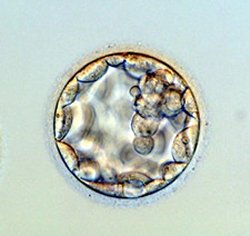 by Preston MacDougall August 18, 2005
"Physician, heal thyself" recently took on a whole new meaning when, this time unexpectedly, Senate Majority Leader Bill Frist changed his own heart regarding his support for President Bush's policy restricting federal funding of research on embryonic stem cells. Frist now backs legislation to ease such restrictions, which was passed by the House of Representatives in May. It also looks as though the Senate will easily pass it when they return from recess, even as President Bush has now repeated his intention to veto it. There is a strong consensus among scientists that this legislation is long overdue, and polls indicate that the percentage of American people who support embryonic stem cell research would be enough to override a veto. It remains to be seen, however, if there will be enough votes in Congress, especially in the House to do so, which on this issue is not being very representative. The House of Representatives has also been the source of some of the more acrid denunciations of Senator Frist's decision, which was soundly based on both scientific and ethical principles. (His floor statement is available at his website frist.senate.gov.) For instance, Charles Boustany, a Louisiana Republican, said that it was "fiscally irresponsible to spend scarce federal dollars on this type of research." Tom DeLay and other conservative members also characterized embryonic stem cell research as "the dismemberment of living, distinct human beings" and "unproven technology". My first response was that the embryonic stem cells are taken from blastocysts that are barely visible to the naked eye, and not from "human beings" with arms and legs that "dismemberment" implies. Moreover, only those blastocysts that are to be discarded by fertility clinics would be used for this potentially life-saving research. I also thought that, by definition, all exploratory research is on "unproven technology". But then I thought maybe they were being satirical. After all, satire is the highest form of battery. I also thought of some much larger outlays of federal funding that might not be as fiscally responsible as these gentlemen seem to prefer. Over 10 billion "scarce federal dollars" are budgeted for the Missile Defense System, which, in February, suffered its third straight failure to intercept a missile that it knew was coming, and where it was coming from. The defensive missile didn't even get off the ground for strike three. When it comes to missile defense, the Pentagon seems to be suffering from projectile dysfunction syndrome, or PDS. Again, there is a strong consensus among scientists in opposition to an idealistic policy of the Bush administration. This year's recipient of the Abel Prize, a sort of Nobel equivalent for mathematicians, is Dr. Peter Lax. He was quoted in the New York Times as saying that the "Star Wars" defense strategy is a "phantasmagoria." I'll let you look that one up in the dictionary, but trust me, any phantasmagoria that has a $10 billion price tag is undoubtedly fiscally irresponsible. The longest stage of the Tour de France is almost 150 miles, by bicycle. The International Space Station has an altitude of 220 miles, putting it not in "space" but rather the Earth's ionosphere. Still, the budget to build it, and even just to take out the garbage, is astronomical - costing "billions and billions" as Carl Sagan would say. Congress used to say that high-quality protein crystals, grown in the "weightless" environment of the Space Station, would enable accurately targeted design of drugs that could cure disease. When a pharmaceutical company launched a new influenza drug called Tamiflu, much ado was made of the fact that the researchers who developed the drug had grown crystals aboard the Space Shuttle, and then later on the Russian Space Station Mir. That is until it was publicly acknowledged that the scientists had concluded there was no difference, aside from cost, between crystals grown in "space" and those grown on Earth. In fact, the particular crystal that was used in the drug design phase was grown in Australia. I have been to Australia, and it is certainly very far away. It is also a really cool place to visit, but it isn't "out of this world." It would be fiscally irresponsible, however, to spend billions of dollars growing crystals on the Space Station that we now know could be just as effectively grown on terra firma. There is a consensus among space scientists that the Space Station doesn't serve a high-priority scientific purpose. So why spend billions of "scarce federal dollars"? Well, I imagine that it is a really cool place to visit, and it is "out of this world." It's just not quite in space. No worries. The President has a plan for the Space Station that he is sure will energize the country and the scientific community. He plans to use it as a stepping-stone to... the moon. And, yes of course, that will cost billions and billions of "scarce federal dollars" too.
|
||
